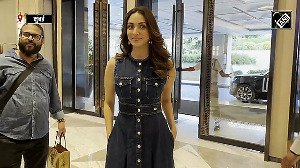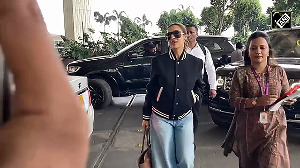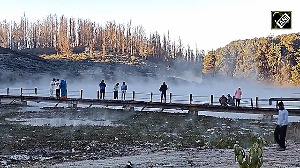The Ambassador for the San Marino Grand Prix, held at Imola, in Italy, woke up typically early in the morning and sighed. It was going to be a tough day. Endless press conferences, flashbulbs. And the questions. Sigh. The same questions, year after year.
San Marino is known for giving the world of motorsport some serious thrills. A fast circuit full of straights and surrounded by the most passionate people in the world, the tifosi, Imola is one of the circuits that separate the men from the boys, its technical challenges pushing the limits of the drivers and always giving the spectators something to remember. Memories and thrills, then. Sometimes more than we wanted.
![]()
Also Read
![]()
![]()
![]()
![]()
The San Marino Grand Prix 2004: Images![]()
Schumi beats Button at Imola![]()
![]()
![]()
1994, the Ambassador reflected, was a particularly bad year. The most remembered of all Formula One weekends, for all the wrong reasons. During Friday practice, an excited Brazilian novice crashed his Jordan, knocking himself out cold and swallowing his tongue. The Ambassador was well aware that, even for Rubens Barrichello himself, it was the least significant part of the weekend. We all empathise. In hindsight, it was just a portent of very ill wind.
The next day Roland Ratzenberger, an Austrian rookie, died in a horrific accident, making a mockery of F1's claims of great safety. The Ambassador recalled his own feelings on that awful day: The tragic agony, the self-doubting introspection. Was it at all worth it? Was anything worth it? Sigh. What a waste of young life.
Ayrton Senna de Silva similarly deliberated for several hours whether to actually race the following day. He visited the scene of the accident, considered the situation carefully, and decided in favour of racing. The triple world champion, considered by some to be among the finest talents in the history of the sport, was more than eager to prove himself. For the first time in many a season, he felt the need to actually fight off a challenger. On the first of May, he raced himself right into immortality.
The Tamburello Curve: today, an innocuous chicane; then, a crucial left-handed curve, taken at speeds upwards of 190 mph. Conspiracy theories have sprung out from several corners, based on the assumption that a driver, a driver like Senna, couldn't possibly have made a mistake that obvious: trying to go flat out, trying to take both lethal bumps instead of, as the technically masterful Prost would have done, lifting off the throttle on the second.
Finally, Damon Hill, Senna's then partner at Williams, has broken his silence. Fed up of all the conspiracy theories, Hill has talked about how Senna was far more motivated that Sunday. He felt the threat of an usurper into his world, a young upstart racing with what he [incorrectly, as has now been proven] felt was an illegally equipped car, and breathing down his neck every race so far. The Ambassador thought about this, too, in disappointed anguish.
Formula One was instantly turned upside down. Two deaths in the sport after 12 years. Safety measures were introduced immediately, and have been increasingly stringent with each passing year, only one of which is the extremely effective HANS (Head And Neck Safety) Harness developed by Professor Sid Watkins a sometimes uncomfortable shoulder attachment, which greatly reduces impact and possibility of damage to the upper body.
For the last 10 years, Formula One has been safe. Far safer, even, than other slower racing formats, including NASCAR and Formula 3. Today we look at racing cars smashing into each other, at Colombian drivers flying off the handle (and, resultantly, off the track) while younger siblings actually manage to levitate. The cars are smashed beyond belief. The drivers? Just annoyed to not be among the points. The restraint is much lesser, and improved safety lets even average drivers glide near the very limit. The Ambassador looked at the qualifying results, with the BAR Honda of Jenson Button and the BMW Williams of Juan Pablo Montoya, and shook his head. In the days with Hakkinen and Hill, or even with Villeneuve, these drivers would have struggled to get into the top six.
This could be San Marino's last race the contract with the FIA had come to an end, and Bernie Ecclestone was adamant about revenue. 2004 might be the very last of Imola. The Ambassador, not worried as much about his resulting loss of official title, was emotionally exhausted. The Circuit Enzo é Dino Ferrari the name rolled off the tongue, awe-inspiring and grand. Undeniably historic. In 1982, the Ambassador sank into nostalgic flashback, the great Gilles Villeneuve was defeated by his Ferrari teammate, Didier Pironi. The Frenchman was incensed at 'the breaking of team orders' and vowed never to speak to Pironi again. He never did. At the very next race in Zolder, Villeneuve was killed in a ghastly accident during qualifying.
In 1983, Villeneuve's friend Patrick Tambay took his number 27 car to an impossibly unlikely victory at Imola. The apocryphal legend goes that Tambay recalled the car doing things of its own accord, things he wouldn't have asked it to do. He said it was as if Gilles had been in the car with him. Here was born the magic of Imola. And now it was coming to an end, because of crass commercialism of a magnificent sport.
The Ambassador sipped his orange juice in sombre silence. The track evoked intensely personal poignant memories for him as well. Last year, he lost his mother on the day of the race, and slipped on a black armband. Ten years ago, he tortured himself for being the man responsible for Ayrton's death, the man because of whom Senna made that fatal mistake. The man who pushed Ayrton too far.
The clock on the table next to his bed beeped discreetly, and he stood up. The Ambassador of The San Marino Grand Prix walked out the door purposefully. He wanted the ghosts of Imola to rest, and he set about doing it the only way he knew how.
He went the distance. He got into a scarlet machine and drove to the finish line, pushing hard every step of the way, even when he didn't need to. Again, he won. Again, he stepped on the podium and smiled and jumped. Again, the tifosi and Imola reverberated with fervent celebration.
His heart was alive. Imola was alive.
Ayrton Senna De Silva, Rest In Peace.
Michel Bless His Soul.







 © 2025 Rediff.com -
© 2025 Rediff.com -